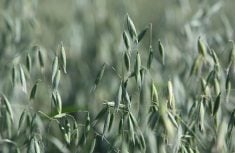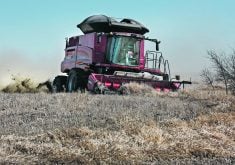Grasshoppers hurt lentils
While grasshopper populations are projected to decline across Saskatchewan in 1994, new research has shown that even at reduced levels the insects can be a problem in lentil crops. Just two or three grasshoppers can cause significant damage to lentil flowers and seed pods.
Research in 1993 “found that grasshopper damage was primarily evident on younger flowers, flower parts and seed pods,” says Bruce Baumann, crops program co-ordinator with Saskatchewan Agriculture.
Grasshoppers appear to have a major impact on yields of lentils at relatively low population densities.
Read Also

VIDEO: Green Lightning and Nytro Ag win sustainability innovation award
Nytro Ag Corp and Green Lightning recieved an innovation award at Ag in Motion 2025 for the Green Lightning Nitrogen Machine, which converts atmospheric nitrogen into a plant-usable form.
In 1993, populations of two to three grasshoppers per square metre damaged up to 23 percent of the viable pods and another 47 percent of flowers and immature pods.
“In the fields that were monitored, grasshopper damage was greatest next to the roadside, and dropped off rapidly after five metres. Although the grasshopper damage leveled off after 20 metres, it did not drop below five percent pod loss,” Baumann said.
Depending on the status of the crop and lentil prices, a five percent loss in seed yield due to grasshopper damage could translate into an economic loss of about $25 per hectare. That’s the equivalent of about $10 per acre.
The research, conducted by Owen Olfert of Agriculture Canada and Al Slinkard of the University of Saskatchewan, will be repeated this summer. The wet 1993 season and the low grasshopper population made it impossible to determine economic thresholds with any certainty.
- Saskatchewan Agriculture
Get canola in early
Seed early and seed Polish, advises Nick Underwood, crop production co-ordinator for the Canola Council of Canada.
Those recommendations apply for farmers considering canola in the drier regions of the southern Prairies that don’t usually grow canola.
“If farmers in the southern Prairies hope to maximize their returns from this high-value crop, they better seed it before their low-value cereals.
“Planting it by the first week of May, if not the last week of April, is ideal,” he said.
Seeding needs to be early so the crop will be through the flowering stage before the heat of mid-July. Hot weather at flowering limits seed development and reduces seed set, which limits yields.
That’s also why Underwood recommends the earlier-maturing Polish varieties.
Other production tips include seeding canola into moist soil at about a 2.5 centimetre (one-inch) depth, preferably with some kind of press wheel behind the seeder.
“Canola also responds rewardingly to proper fertility.”
Complete information on management practices for canola production can be found in the Canola Growers Manual now being reprinted.
It can be ordered by sending a cheque for $48.15 (includes GST) to the Canola Council of Canada, 400 -1 67 Lombard Avenue, Winnipeg, Man., R3B OT6.
- Canola Council of Canada














